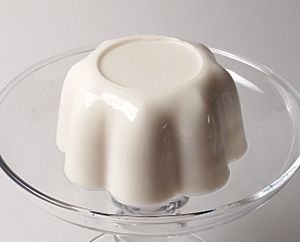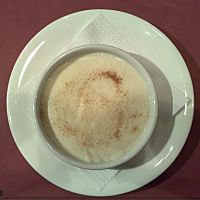Blancmange facts for kids

A blancmange set on a glass platter
|
|
| Course | Dessert |
|---|---|
| Serving temperature | Cold |
| Main ingredients | Milk or cream; sugar; gelatin, cornstarch or Irish moss; almonds |
Blancmange (pronounced blahn-MAHNZH) is a yummy, sweet dessert. It's usually made with milk or cream and sugar. To make it thick, people use things like rice flour, gelatin, corn starch, or a type of seaweed called Irish moss. It often tastes like almonds.
This dessert is typically poured into a mold to set. Then, it's served cold. The name "blancmange" means "white eating" in French. Even though it's traditionally white, you can find blancmanges in many different colors today! Some other desserts that are a bit like blancmange include Bavarian cream from France, panna cotta from Italy, and annin tofu from China.
Blancmange has a long history. It first appeared in the Middle Ages. Back then, it was quite different! It often had capon or chicken, milk (or almond milk), rice, and sugar. People thought it was a perfect food for those who were sick. Today, there's a sweet Turkish pudding called Tavuk göğsü that's similar to the old medieval dish. It's even made with shredded chicken!
Contents
The Story of Blancmange
The exact beginning of blancmange is a bit of a mystery. Some people think it came about when Arabs brought rice and almonds to Europe a long time ago. However, we don't have clear proof of similar Arab dishes from that time. Still, a Persian dish called muhallebi is quite similar, but its origins are also unclear.
You can find versions of blancmange in many European countries. They often have names that sound alike, like biancomangiare in Italy and manjar blanco in Spain. Other similar dishes existed too, but with different names. For example, in Denmark, there was hwit moos ("white mush") in the 1200s.
The oldest recipe we've found for blancmange is from a Danish cookbook. It was written by Henrik Harpestræng, who passed away in 1244. This means the recipe is from the early 1200s or even earlier! This Danish book might have been a translation of a German cookbook. That German book might have come from an even older Latin or Romance language manuscript from the 1100s.
Blancmange in the Middle Ages
The "whitedish," as it was called in Old French (blanc mangier), was a fancy dish. It was popular among the upper classes across most of Europe during the Middle Ages and early modern period. You can find countless recipes for it in old cookbooks from all over Europe. It was one of the few dishes that was truly international back then!
The whitedish is even mentioned in Geoffrey Chaucer's famous book, The Canterbury Tales. It also appears in a cookbook from the early 1400s. This book was written by the chefs of King Richard II.
The main ingredients were usually milk or almond milk, sugar, and shredded chicken (often a capon) or fish. These were often mixed with rosewater and rice flour to make a mild stew. On fast days or during Lent, people used almond milk and fish instead of other animal products. Sometimes, spices like saffron or cinnamon were added. The chicken could also be swapped for other birds like quail or partridge. Spices were very popular in later medieval recipes because they showed off wealth and status.
Colorful Blancmange
For special parties and among rich families, whitedishes were often made even more exciting with colors!
- They used saffron to make it a reddish-golden yellow.
- Various herbs could make it green.
- Sandalwood gave it a russet (reddish-brown) color.
In 14th-century France, it was very popular to use two bright, contrasting colors on the same plate. This was described by Guillaume Tirel, also known as Taillevent. He was a main author of later versions of the cookbook Le Viandier. These brightly colored whitedishes were some of the first entremets. An entremet was a dish meant to entertain and delight people with its fancy look, as much as its taste!
Blancmange Today
In the 1600s, the whitedish started to change. It became a meatless pudding dessert made with cream and eggs. Later, gelatin was added. By the 1800s, people started adding arrowroot and cornflour. This is how the dish slowly became the modern blancmange we know today!
What's in a Name?
The word "blancmange" comes from the Old French words blanc mangier. This means "white eating" or "white dish." The name "whitedish" is a modern term used by some historians. But the original name was always a direct translation or a similar sounding word from the Old French.
Many different local names were used for this dish in the Middle Ages:
- English: blancmanger, blankmanger
- Catalan: menjar blanch, menjar blanc
- Portuguese: manjar branco
- Italian: mangiare bianco, biancomangiare
- Spanish: manjar blanco
- German: Blamensir
While it's pretty clear the name means "white dish," old medieval writings don't always agree on the actual color of the dish. One food expert, Terence Scully, has suggested another idea. He thinks it might come from bland mangier, meaning "bland dish." This would describe its often mild and refined taste. It was also popular as a dish for sick people.
See also
 In Spanish: Manjar blanco para niños
In Spanish: Manjar blanco para niños


